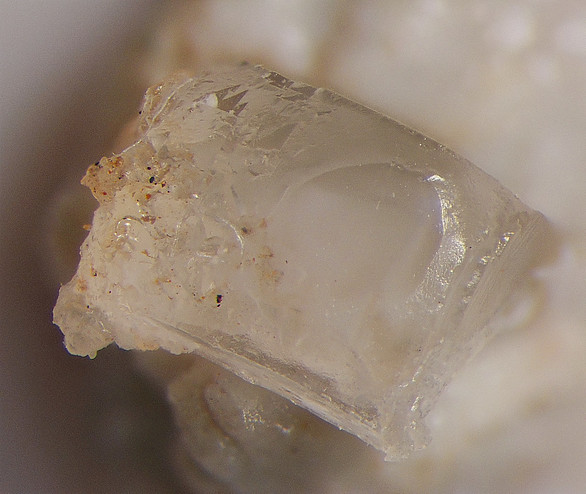Aristarainite
A valid IMA mineral species
This page is currently not sponsored. Click here to sponsor this page.
About Aristarainite
Formula:
Na2MgB12O20 · 8H2O
Colour:
Colourless, white
Lustre:
Vitreous
Hardness:
3½
Specific Gravity:
2.027
Crystal System:
Monoclinic
Name:
Named in honor of Lorenzo Francisco Aristarain (1926-2013), Argentine mineralogist at La Plata University, Buenos Aires, Argentina. He specialized in borate deposits and described five minerals (rivadavite, ameghinite, teruggite, beusite, and olsacherite).
This page provides mineralogical data about Aristarainite.
Unique Identifiers
Mindat ID:
334
Long-form identifier:
mindat:1:1:334:0
GUID
(UUID V4):
(UUID V4):
b88f48ff-e3cd-4f61-ab53-af69720b76ee
IMA Classification of Aristarainite
Approved
IMA Formula:
Na2Mg[B6O8(OH)4]2 · 4H2O
Approval year:
1973
First published:
1974
Classification of Aristarainite
6.FB.05
6 : BORATES
F : Hexaborates
B : Ino-hexaborates
6 : BORATES
F : Hexaborates
B : Ino-hexaborates
26.6.5.1
26 : HYDRATED BORATES CONTAINING HYDROXYL OR HALOGEN
6 : Hexaborates
26 : HYDRATED BORATES CONTAINING HYDROXYL OR HALOGEN
6 : Hexaborates
9.1.12
9 : Borates
1 : Borates of the alkalis and boric acid
9 : Borates
1 : Borates of the alkalis and boric acid
Mineral Symbols
As of 2021 there are now IMA–CNMNC approved mineral symbols (abbreviations) for each mineral species, useful for tables and diagrams.
| Symbol | Source | Reference |
|---|---|---|
| Ais | IMA–CNMNC | Warr, L.N. (2021). IMA–CNMNC approved mineral symbols. Mineralogical Magazine, 85(3), 291-320. doi:10.1180/mgm.2021.43 |
Physical Properties of Aristarainite
Vitreous
Transparency:
Transparent, Translucent
Colour:
Colourless, white
Streak:
White
Hardness:
3½ on Mohs scale
Tenacity:
Brittle
Cleavage:
Perfect
Perfect on {001}, {100}.
Fair {110}.
Perfect on {001}, {100}.
Fair {110}.
Fracture:
Splintery
Density:
2.027(5) g/cm3 (Measured) 2.005 g/cm3 (Calculated)
Optical Data of Aristarainite
Type:
Biaxial (+)
RI values:
nα = 1.484 nβ = 1.498 nγ = 1.523
2V:
Measured: 70° , Calculated: 76°
Max Birefringence:
δ = 0.039

Image shows birefringence interference colour range (at 30µm thickness)
and does not take into account mineral colouration.
and does not take into account mineral colouration.
Surface Relief:
Moderate
Dispersion:
r > v to r < v strong
Optical Extinction:
X = b; Y ∧ c = –38°; Z ∧ a = 46°.
Chemistry of Aristarainite
Mindat Formula:
Na2MgB12O20 · 8H2O
Crystallography of Aristarainite
Crystal System:
Monoclinic
Class (H-M):
2/m - Prismatic
Space Group:
P21/b
Setting:
P21/a
Cell Parameters:
a = 18.886 Å, b = 7.521 Å, c = 7.815 Å
β = 97.73°
β = 97.73°
Ratio:
a:b:c = 2.511 : 1 : 1.039
Unit Cell V:
1,099.97 ų (Calculated from Unit Cell)
Z:
2
Morphology:
Tabular or elongated crystals on [010], rosette aggregates, crusts. Common forms: {001},{100}, {110}, less common: {210}, {201}, {401}, {211} and {211}.
Crystal Structure
Load
Unit Cell | Unit Cell Packed
2x2x2 | 3x3x3 | 4x4x4
Unit Cell | Unit Cell Packed
2x2x2 | 3x3x3 | 4x4x4
Show
Big Balls | Small Balls | Just Balls | Spacefill
Polyhedra Off | Si Polyhedra | All Polyhedra
Remove metal-metal sticks
Big Balls | Small Balls | Just Balls | Spacefill
Polyhedra Off | Si Polyhedra | All Polyhedra
Remove metal-metal sticks
Display Options
Black Background | White Background
Perspective On | Perspective Off
2D | Stereo | Red-Blue | Red-Cyan
Black Background | White Background
Perspective On | Perspective Off
2D | Stereo | Red-Blue | Red-Cyan
View
CIF File Best | x | y | z | a | b | c
CIF File Best | x | y | z | a | b | c
Rotation
Stop | Start
Stop | Start
Labels
Console Off | On | Grey | Yellow
Console Off | On | Grey | Yellow
Data courtesy of the American Mineralogist Crystal Structure Database. Click on an AMCSD ID to view structure
| ID | Species | Reference | Link | Year | Locality | Pressure (GPa) | Temp (K) |
|---|---|---|---|---|---|---|---|
| 0000598 | Aristarainite | Ghose S, Wan C (1977) Aristarainite: Na2Mg[B6O8(OH)4]2.4H2O: a sheet structure with chains of hexaborate polyanions American Mineralogist 62 979-989 |  | 1977 | 0 | 293 |
CIF Raw Data - click here to close
X-Ray Powder Diffraction
Powder Diffraction Data:
| d-spacing | Intensity |
|---|---|
| 7.74 Å | (100) |
| 2.579 Å | (19) |
| 3.037 Å | (13) |
| 3.869 Å | (12) |
| 5.40 Å | (11) |
| 2.400 Å | (10) |
| 3.782 Å | (9) |
Geological Environment
Paragenetic Mode(s):
| Paragenetic Mode | Earliest Age (Ga) |
|---|---|
| Near-surface Processes | |
| 25 : Evaporites (prebiotic) |
Geological Setting:
Borax spring
Type Occurrence of Aristarainite
General Appearance of Type Material:
Small crystals up to 0.3mm in length, and 0.05 by 0.05 in cross section.
Place of Conservation of Type Material:
Natural History Museum, Paris, France.
Harvard University, Cambridge, Massachusetts, USA, 109679.
National Museum of Natural History, Washington, D.C., USA, 136046, 137296.
Harvard University, Cambridge, Massachusetts, USA, 109679.
National Museum of Natural History, Washington, D.C., USA, 136046, 137296.
Geological Setting of Type Material:
Playa evaporite.
Associated Minerals at Type Locality:
Reference:
Hurlbut, C.S., Erd, R.C. (1974) Aristarainite, Na2O∙MgO∙6B2O3∙10H2O, a new Mineral from Salta, Argentina. American Mineralogist: 59: 647-651.
Synonyms of Aristarainite
Other Language Names for Aristarainite
Related Minerals - Strunz-mindat Grouping
| 6.FB.10 | Kaliborite | KMg2H[B6O8(OH)5]2(H2O)4 |
Fluorescence of Aristarainite
Moderate cream white in SW, weakly phosphorescent.
Other Information
IR Spectrum:
A peak at 3640 is due to the presence of OH- and a broad peak at 3420 to the presence of H2O. A band from 1150 to 1450 indicates boron in triangular coordination; bands from 805 to 1095 indicate boron in tetrahedral coordination.
Notes:
Not soluble, or only slightly soluble, in hot water (66°C). Very soluble in cold 1:1 HCl.
Fuses easily to a clear glass with n = 1.510.
Fuses easily to a clear glass with n = 1.510.
Health Risks:
No information on health risks for this material has been entered into the database. You should always treat mineral specimens with care.
Internet Links for Aristarainite
mindat.org URL:
https://www.mindat.org/min-334.html
Please feel free to link to this page.
Please feel free to link to this page.
Search Engines:
External Links:
Mineral Dealers:
References for Aristarainite
Reference List:
Erd, Cornelius S. Hurlbut,and Richard C. (1974) Aristarainite, Na2O·MgO·6B2O3·10H2O, a new mineral from Salta, Argentina. American Mineralogist, 59 (7-8) 647-651
Localities for Aristarainite
Locality List
 - This locality has map coordinates listed.
- This locality has map coordinates listed.
 - This locality has estimated coordinates.
ⓘ - Click for references and further information on this occurrence.
? - Indicates mineral may be doubtful at this locality.
- This locality has estimated coordinates.
ⓘ - Click for references and further information on this occurrence.
? - Indicates mineral may be doubtful at this locality.
 - Good crystals or important locality for species.
- Good crystals or important locality for species.
 - World class for species or very significant.
(TL) - Type Locality for a valid mineral species.
(FRL) - First Recorded Locality for everything else (eg varieties).
- World class for species or very significant.
(TL) - Type Locality for a valid mineral species.
(FRL) - First Recorded Locality for everything else (eg varieties).
All localities listed without proper references should be considered as questionable.
Argentina (TL) | |
| Helvaci +4 other references |
Turkey | |
| J. García-Veigas et al. (2010) +1 other reference |
USA | |
| a spectroscopic exploration. Economic ... +1 other reference |
| Erd et al. (1979) |
Quick NavTopAbout AristarainiteUnique IdentifiersIMA Classification Classification Mineral SymbolsPhysical Properties Optical Data Chemistry Crystallography Crystal StructureX-Ray Powder DiffractionGeological EnvironmentType Occurrence SynonymsOther LanguagesStrunz-MindatFluorescence Other InformationInternet Links References Localities Locality List





 symbol to view information about a locality.
The
symbol to view information about a locality.
The 



Eagle Borax Spring, Inyo County, California, USA